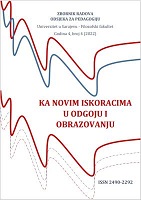ASISTIVNA TEHNOLOGIJA U NASTAVNOJ PRAKSI: PRILIKE I PREPREKE
ASSISTIVE TECHNOLOGY IN TEACHING PRACTICE: OPPORTUNITIES AND OBSTACLES
Author(s): Anida Manko, Sandra BjelanSubject(s): ICT Information and Communications Technologies, Inclusive Education / Inclusion, Pedagogy
Published by: Filozofski fakultet Univerziteta u Sarajevu
Keywords: differentiation; teacher competences; low; mid; high tech; participation and learning;
Summary/Abstract: Obstacles in participation and learning can happen on different levels and stages of complex teaching processes and be conditioned upon different factors. Teacher competences in inclusive education should include knowledge and skills relevant for improving learning and teaching as well as their ability to prevent or minimize obstacles in students' learning and participation. Differentiation of the learning environment, process, teaching materials and strategies, didactic materials and teaching aid is an adequate didactic and methodological intervention of a competent teacher in an attempt to overcome obstacles and restrictions in learning and participation. Differentiation is based on teachers' competences and their abilities to recognize and meet their students' needs through different approaches, processes and tools in order to increase the chance of achieving the learning outcomes and full potential of each student. In the process of adapting, it is important to provide assistive technology in order to increase, sustain and improve functional abilities of persons with disabilities. Assistive technology is also intended for other education experts such as: teachers, pedagogues, psychologists, expert teams, assistant teachers and personal assistants. The aim of this research was to identify opportunities and obstacles in implementing assistive technology in education processes. One hundred elementary and high school teachers and associates from the Sarajevo Canton, Una-Sana Canton, West Herzegovina Canton and Republic of Srpska participated in the research. The research results, among other things, indicate that the participants are not familiar with categories of assistive technology and that a majority of them chooses adequate assistive technology based on the students’ disabilities only. The results also show that the participants do not use assistive technology often enough, that is, only sometimes, and that the educational institutions are insufficiently equipped with assistive technology. These results have been confirmed through self-evaluation of the research subjects as well, in which a majority of them stated their competences for using elementary assistive technologies are minimal. This paper shows the situation in practice and aims to look into the potentiality and opportunities for comprehensive implementation of assistive technology in education.
Journal: Zbornik radova Odsjeka za pedagogiju
- Issue Year: 4/2022
- Issue No: 4
- Page Range: 8-25
- Page Count: 18
- Language: Bosnian

